As we navigate the complexities of modern work environments, effective Top Project Management Tools 2025 has become crucial for teams of all sizes. With the rise of remote and hybrid work setups, the demand for innovative and efficient management tools has never been higher.
We’re on the cusp of 2025, and the landscape of project management solutions is more diverse than ever. In this article, we’ll explore the most cutting-edge tools available, comparing their unique features, pricing structures, and best use cases to help you make an informed decision.
Key Takeaways
- Discover the most innovative project management solutions for 2025.
- Compare features, pricing, and use cases for top tools.
- Find the perfect tool to streamline your workflow.
- Learn how modern tools cater to remote and hybrid work environments.
- Get insights into user experience, customisation, and integration capabilities.
Why Project Management Tools Are Essential in 2025
As we step into 2025, the importance of project management tools cannot be overstated in today’s fast-paced business environment. Everyone has a different way of managing projects, ranging from using their inbox to keep track of tasks, visualising work on a Kanban board, or even relying on the traditional pen and paper system. However, when collaborating on projects as a team, a flexible and capable project management tool that works for everyone is essential.
With the rise of remote and hybrid work models, the need for robust project management software has become even more pressing. Such tools help track projects, facilitate collaboration, and keep everyone informed. In this section, we’ll explore why project management tools are crucial for modern teams.

The Evolution of Project Management Software
Project management software has undergone significant evolution, transforming from simple task lists to sophisticated platforms that integrate AI, automation, and advanced analytics. This evolution has been driven by the changing needs of teams and the increasing complexity of projects. Modern project management tools now offer a wide range of features that cater to diverse project requirements, making them indispensable for teams aiming to deliver projects efficiently.
The shift towards remote and hybrid work models has further accelerated the development of these tools, with a focus on enhancing collaboration and productivity. As a result, project management software has become more intuitive, allowing teams to work seamlessly across different locations and time zones.
Benefits of Using Dedicated Project Management Tools
Implementing dedicated project management tools brings numerous benefits to organisations. These include improved efficiency, better resource allocation, and enhanced visibility across projects. By using a dedicated management tool, teams can streamline their workflows, reduce miscommunication, and ensure that everyone is aligned with project goals and timelines.
Moreover, modern project management tools provide real-time updates and insights, enabling teams to make informed decisions and adapt to changing project requirements. This level of agility is crucial in today’s fast-paced business environment, where the ability to respond quickly to changes can be a significant competitive advantage.
Key Challenges Modern Teams Face Without Proper Tools
Without proper project management tools, modern teams face several challenges, including miscommunication, missed deadlines, and scope creep. These issues can lead to decreased productivity, increased stress, and ultimately, project failure. By leveraging the right project management software, teams can overcome these challenges and ensure successful project outcomes.
A key benefit of using project management tools is the creation of a single source of truth for teams, eliminating confusion and ensuring everyone stays aligned on priorities and progress. This is particularly important in large and complex projects, where multiple stakeholders need to be kept informed and engaged.
How We Evaluated These Project Management Tools
To determine the top project management tools, we employed a rigorous testing methodology that assessed their features and performance. Our evaluation process was designed to identify the best solutions for various team needs and project types.
Our Testing Methodology
Our comprehensive testing methodology involved hands-on evaluation of each tool across various team sizes and project types. We assessed the user experience of each management software, considering factors like learning curve, interface design, and overall usability for both technical and non-technical team members. This approach allowed us to ensure that our recommendations are reliable and applicable to real-world scenarios.
We tested the tools’ ability to handle multiple teams, project types, and organization styles. Our evaluation also included assessing the tools’ features, such as task management capabilities, collaboration tools, reporting functions, and customisation options. By doing so, we gained a thorough understanding of each tool’s strengths and weaknesses.

Key Features We Looked For
When evaluating project management tools, we prioritised several key features. These included task management capabilities, collaboration tools, reporting functions, and customisation options. We looked for tools that offered flexible features to accommodate different project management methodologies and team needs.
Our analysis revealed that the top tools provided seamless integration with other popular business applications, such as email, Slack, calendars, and document storage. This integration capability is crucial for creating a cohesive workflow ecosystem.
Pricing Considerations
Pricing is a critical factor when selecting a management software. Our evaluation involved analysing the pricing structures of each tool, looking beyond the headline figures to understand the true value offered at each tier. We identified any hidden costs or limitations that might impact the overall cost-effectiveness of the tool.
By considering both the pricing and the features offered, we were able to assess the overall value proposition of each tool. This enabled us to provide recommendations that balance cost with functionality and performance.
Top Project Management Tools 2025: At a Glance
With the ever-growing demand for efficient project management, 2025 presents a diverse range of tools tailored to various team sizes and sectors. In this section, we will provide an overview of the top project management tools available, comparing their features, pricing, and suitability for different teams and industries.
Comparison Table of Features and Pricing
To help you quickly identify the best project management tool for your needs, we’ve compiled a comprehensive comparison table that outlines the core features and pricing tiers of the top tools.
| Tool Name | Best For | Pricing | Key Features |
|---|---|---|---|
| ClickUp | Advanced AI-enabled project management | From $0 to $19 per month; custom pricing for enterprise plans | AI task management, customizable workflows |
| Asana | No-frills project management | From $0 to $30.49 per month; custom pricing for enterprise plans | Task assignments, workflow automation |
| Trello | Visualizing workflows as a digital Kanban Board | From $0 to $17.50 per month for 50 users | Boards, lists, cards, Power-Ups |
| Wrike | Managing stakeholders | From $0 to $24.80 per month; custom pricing for enterprise plans | Task management, stakeholder analysis |
| Monday | Scalable project management | From $0 to $24 per month; custom pricing for enterprise plans | Customizable workflows, automations |
The table above highlights the diversity in project management tools available, catering to different needs and budgets. When choosing a tool, it’s essential to consider both the features and the pricing model to ensure it aligns with your team’s requirements.
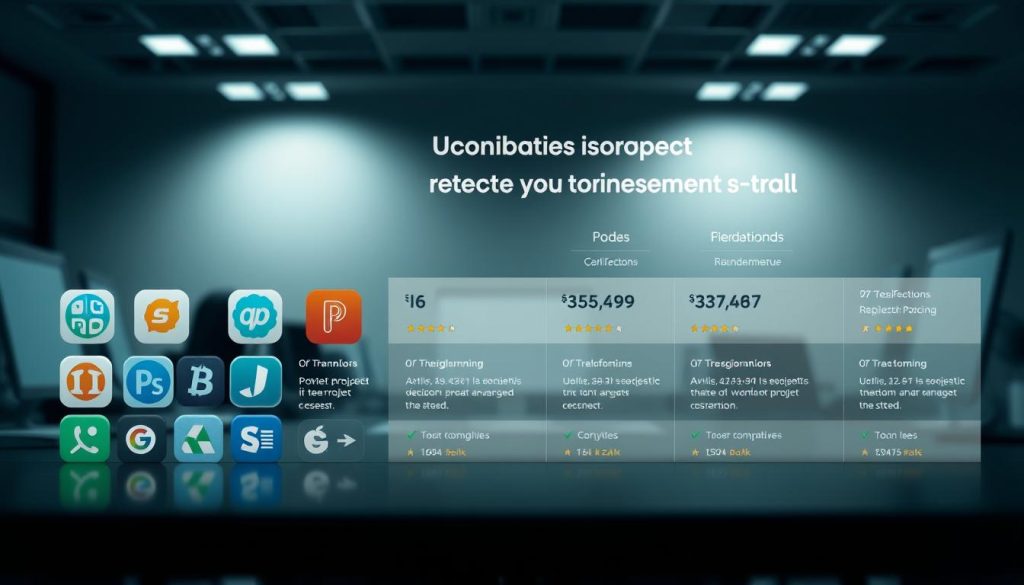
Best Tools for Different Team Sizes and Industries
Different teams have unique needs based on their size, industry, and specific requirements. Here’s a breakdown of the best project management tools for various team sizes and industries:
- Small Teams: Tools like Trello and Asana are ideal for small teams due to their simplicity and ease of use.
- Large Enterprises: For larger organizations, tools like Wrike and Monday offer scalable solutions with advanced features.
- Software Development: Jira is particularly suited for software development teams, offering robust support for agile methodologies.
- Creative Industries: Tools like Basecamp and Adobe Workfront cater to the needs of creative teams, offering features like collaborative workspaces and resource allocation.
By understanding the specific needs of your team and industry, you can select a project management tool that not only meets your current requirements but also scales with your growth.
ClickUp: The All-in-One Project Management Solution
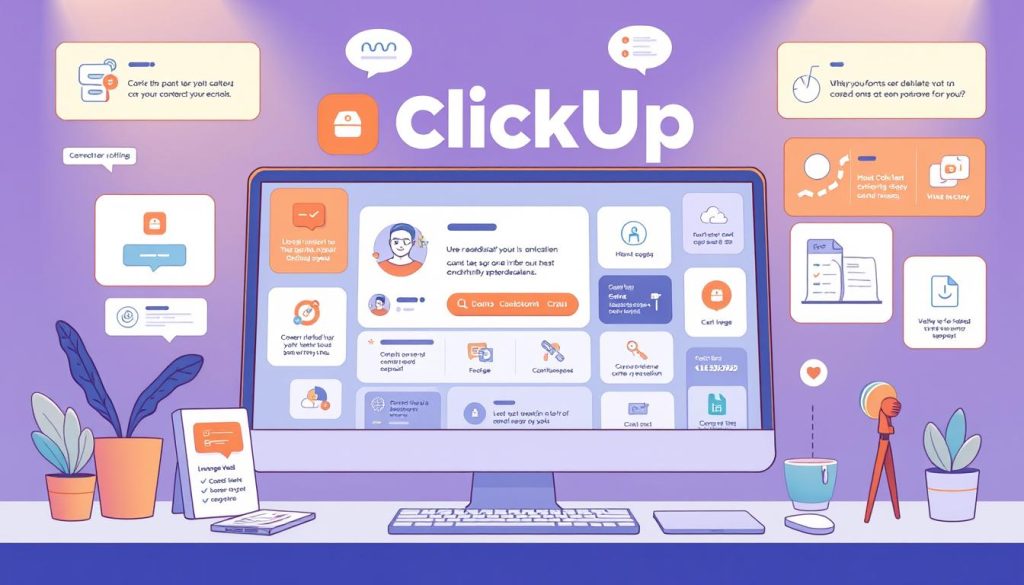
In the realm of project management tools, ClickUp stands out for its versatility and feature-rich environment. ClickUp has evolved significantly since its inception, becoming a comprehensive project management software that caters to diverse team needs.
Overview
ClickUp is designed to be an all-encompassing management tool that streamlines tasks, projects, and workflows. It offers a wide range of features, including customisable views, comprehensive task management, goal tracking, and document management.
Key Features
ClickUp’s standout features include its ability to map out entire project lifecycles, from high-level Spaces and Folders down to Lists, Tasks, and Subtasks. This hierarchical structure allows for priorities, dependencies, and custom fields to be integrated seamlessly.
The platform also boasts robust automation capabilities, reducing manual effort and enhancing productivity. Additionally, ClickUp’s customisable views enable teams to visualise their projects in the most suitable format, whether it’s List, Board, or Gantt view.
Pricing Structure
ClickUp offers a flexible pricing structure to accommodate different team sizes and needs. The plans range from a generous Free Forever plan to custom Enterprise solutions.
- Free Forever: Ideal for small teams or individuals.
- Unlimited: $7/month, offering advanced features and increased storage.
- Business: $12/month per user, providing additional features and support.
- Enterprise: Custom pricing for large organisations with specific needs.
ClickUp Brain, the AI-powered assistant, can be added to any paid plan for $7 per Workspace member per month, enhancing project management with intelligent suggestions and automated task creation.
Pros
One of ClickUp’s significant advantages is its exceptional flexibility, allowing teams to tailor the platform to their specific workflows and needs. The robust automation capabilities and seamless integration with other tools in the tech stack further enhance its appeal.
The platform’s ability to manage tasks efficiently, with features like task dependencies and custom fields, makes it a powerful tool for project management.
Cons
While ClickUp offers a wide range of features, it can have a steep learning curve for new users. Some teams may find the initial setup and configuration process time-consuming.
Additionally, while the Free Forever plan is generous, certain advanced features are only available in the paid plans, which may limit functionality for teams on a tight budget.
ClickUp Brain: AI-Powered Project Management
ClickUp Brain represents a significant advancement in AI-powered project management. This feature enhances project planning and execution by providing intelligent suggestions, automating tasks, and offering predictive analytics.
By integrating AI into the project management process, ClickUp Brain helps teams work more efficiently, anticipate potential issues, and make data-driven decisions.
Asana: Streamlined Task Management for Teams

Asana has revolutionised task management for teams with its intuitive and powerful project management solution. It’s designed to help teams stay organised and on track, making it an essential tool for modern workplaces.
Overview
Asana is a project management tool that enables teams to break down projects into sections and sub-lists, track progress, and collaborate effectively. Its flexible project views, including list, board, and calendar views, cater to different team preferences.
Key Features
Asana’s key features include workflow management capabilities, goal tracking, and team collaboration tools. Its task management features allow users to add, rearrange, and complete tasks with ease.
Pricing Structure
Asana offers a free Personal plan with unlimited projects, tasks, and storage for up to 15 users. The Starter plan, priced at $10.99/user/month (billed annually), adds features like Gantt and timeline views, extensive reports, and Asana AI.
Pros
Asana’s strengths include its clean user interface, excellent task dependency management, and robust reporting capabilities. These features make it a favourite among teams seeking a streamlined task management solution.
Cons
While Asana excels in many areas, it may have limitations in certain aspects, such as advanced customisation options or integration with specific third-party tools.
Asana Intelligence: Smart Project Management
Asana Intelligence is the platform’s AI-powered feature set, designed to enhance productivity through smart task suggestions, workload balancing, and predictive insights. This feature is particularly useful for teams looking to optimise their workflow.
Trello: Visual Kanban-Style Project Management
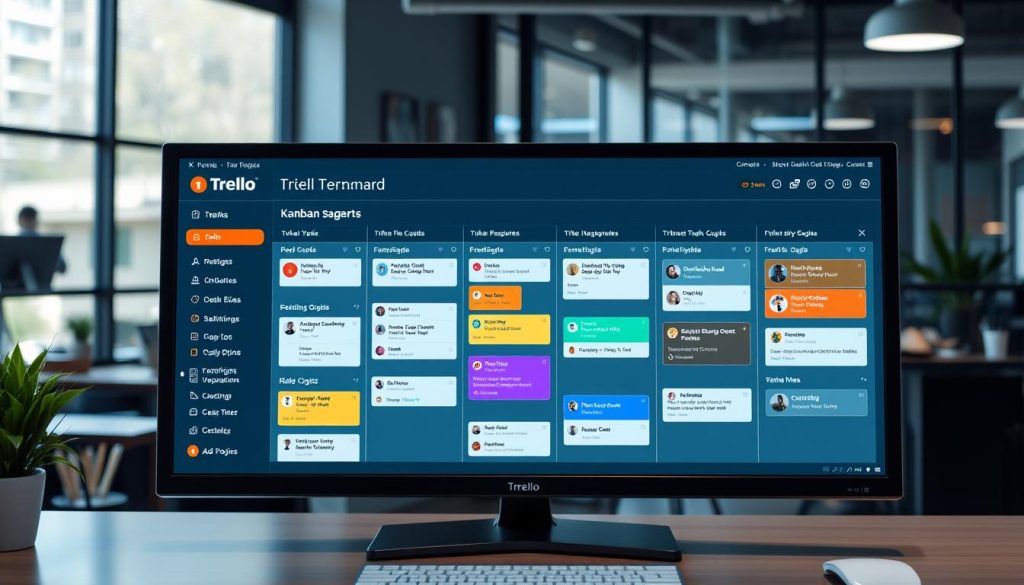
Trello has revolutionised project management with its intuitive Kanban boards, making it a favourite among teams seeking simplicity. As a visual project management tool, Trello allows users to organise their projects into boards, lists, and cards, providing a clear overview of ongoing work.
Overview
Trello is a simple yet powerful project management software that utilises Kanban boards to help individuals and teams organise their work. With its generous free plan, Trello is accessible to anyone, from freelancers managing personal projects to large teams building complex workflows.
Users can start by creating a new board from scratch or choosing from dozens of pre-designed templates across various categories such as marketing, sales, and design. Trello’s flexibility makes it adaptable to different project types and team sizes.
Key Features
Trello’s core features include boards, lists, and cards, which together form a robust system for visual task management. Users can customise lists to represent different stages of their workflow, such as to-do, in progress, and done.
Cards can be enhanced with labels, due dates, members, checklists, images, attachments, and comments, keeping all relevant information in one place. The drag-and-drop functionality allows for easy movement of cards across lists as tasks progress.
Pricing Structure
Trello offers a tiered pricing structure to suit different needs. The free plan includes unlimited cards and members, 10 boards per workspace, unlimited Power-Ups, and 250 automated commands per month.
For more advanced features, the Standard plan costs $5 per user per month (billed annually) and includes unlimited boards, custom fields, advanced checklists, and up to 1,000 automated commands per month.
Pros
Trello’s strengths lie in its exceptional ease of use, visual workflow management, and flexibility. The platform is highly intuitive, making it easy for new users to get started quickly.
The visual nature of Trello’s Kanban boards provides a clear overview of project progress, helping teams stay organised and focused.
Cons
While Trello excels in simplicity and visual management, it may lack some advanced features required for complex project management needs. Teams with intricate project requirements might find Trello’s basic features limiting.
However, Trello’s Power-Ups ecosystem significantly enhances its functionality, offering integrations and additional features that can address more complex needs.
Power-Ups: Extending Trello’s Functionality
Trello’s Power-Ups are integrations and features that can be added to boards to enhance their functionality. With unlimited Power-Ups available even on the free plan, users can customise their boards to suit specific needs.
Power-Ups allow users to view tasks on a calendar, add voting options to cards, automate repetitive tasks, and much more, significantly extending Trello’s core capabilities.
Monday.com: Flexible Work Management Platform
Monday.com has emerged as a leading work management platform, offering teams a visually intuitive way to manage their workflows.
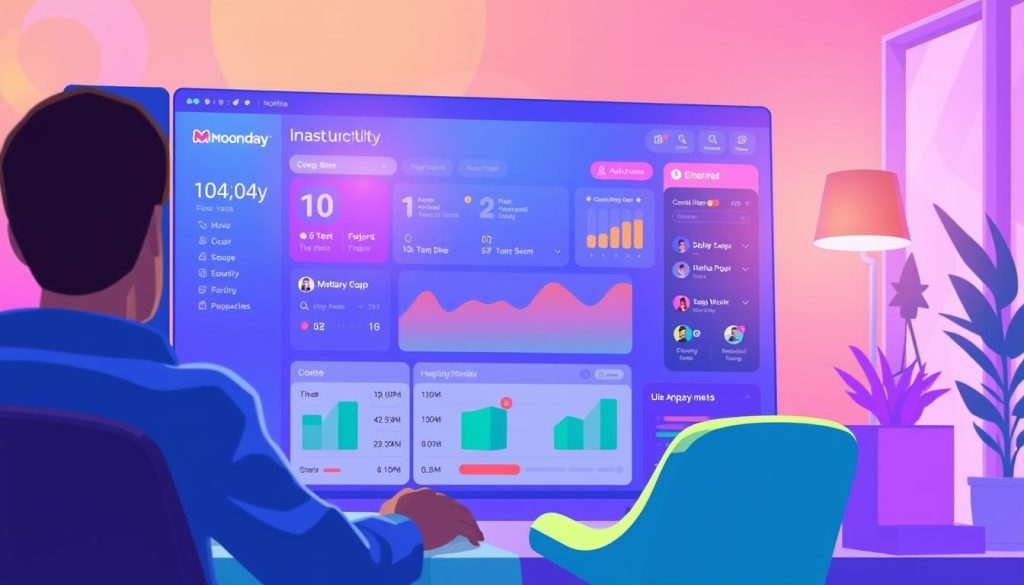
Overview
Monday.com is designed to provide teams with a highly customisable platform for managing their work. Its interface is both visually appealing and intuitive, making it easier for teams to track their projects and workflows.
Key Features
The platform boasts several key features, including boards, columns, automations, and dashboards. These features enable teams to create tailored project management systems that meet their specific needs.
Boards allow teams to visualise their workflows, while columns provide the flexibility to track different aspects of their projects. Automations help streamline repetitive tasks, and dashboards offer a clear overview of project progress.
Pricing Structure
Monday.com offers a range of pricing plans, from a free tier to enterprise-level solutions. The pricing structure is designed to accommodate teams of various sizes and needs.
As teams grow, they can upgrade to higher-tier plans that offer additional features and capabilities. Understanding the pricing structure is crucial for teams to identify the best value option for their needs.
Pros
Monday.com’s strengths lie in its exceptional visualisation capabilities, intuitive interface, and powerful automation features. These aspects make it a standout choice for teams seeking to enhance their project management processes.
The platform’s customisable workflows and extensive template library further contribute to its appeal, allowing teams to quickly implement best practices and tailor the platform to their needs.
Cons
While Monday.com offers numerous benefits, it also has some limitations. For instance, some users may find the reporting features challenging to master initially.
Additionally, occasional syncing issues with integrated apps can disrupt workflows. However, these issues can often be resolved through manual reconnection or adjustments to the integration settings.
Customisation Options and Templates
Monday.com’s extensive customisation options and template library are significant advantages. The platform offers a range of templates for different projects and workflows, which can be tailored to meet specific team needs.
These templates provide a solid starting point, allowing teams to quickly set up their workflows and begin managing their projects effectively.
Wrike: Enterprise-Grade Project Management

With its enterprise-grade capabilities, Wrike is the go-to project management solution for many large organisations. Wrike offers the flexibility of a spreadsheet, allowing users to track various task details and update task statuses at different intervals.
Overview of Wrike
Wrike is designed to cater to the complex needs of larger organisations. It provides a robust set of features that enable teams to manage multiple projects simultaneously.
Key Features
Wrike’s key features include work breakdown structures, resource management capabilities, custom workflows, and comprehensive reporting tools. These features enable teams to plan, execute, and monitor projects effectively.
The platform also offers advanced project management capabilities, such as Gantt charts and time tracking, which are available in its premium plans.
Pricing Structure
Wrike offers a free plan with limited features, as well as several paid plans that scale with the needs of the organisation. The pricing starts at $10/user/month (billed annually) for the Team plan, which includes additional features like Gantt charts and AI capabilities.
The pricing structure is designed to accommodate businesses of various sizes, from small teams to large enterprises.
Pros of Using Wrike
One of the main advantages of Wrike is its exceptional flexibility and powerful customisation options. It also offers advanced security features that meet enterprise compliance requirements.
Wrike’s ability to scale with the organisation makes it an attractive choice for businesses planning to grow.
Cons of Using Wrike
Despite its many benefits, Wrike has a learning curve that can be challenging for some users. Additionally, simpler alternatives might be more suitable for certain team types or smaller projects.
Stakeholder Management Capabilities
Wrike’s approval workflows, custom dashboards, and reporting features facilitate clear communication with stakeholders, including executives, clients, and other project stakeholders.
These capabilities ensure that all parties are informed and aligned throughout the project lifecycle.
Smartsheet: Spreadsheet-Powered Project Management
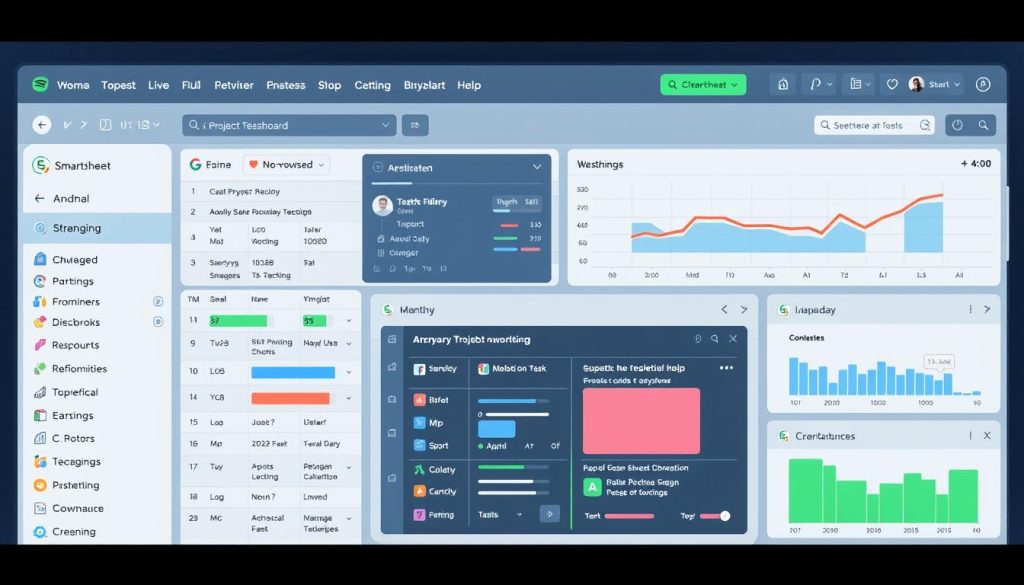
Smartsheet seamlessly blends the intuitive nature of spreadsheets with advanced project management features, making it an ideal solution for teams familiar with Excel but needing more robust capabilities.
Overview
Smartsheet is a powerful project management tool that leverages the familiarity of spreadsheets to provide a versatile solution for managing tasks, tracking timelines, and collaborating with teams. Its interface is similar to traditional spreadsheet software, reducing the learning curve for new users.
Key Features
Smartsheet’s core features include its grid view, automated workflows, form collection capabilities, and robust reporting tools. These features make it particularly appealing to data-driven teams who require flexibility in data manipulation and formula capabilities.
Pricing Structure
Smartsheet offers a tiered pricing structure, starting with a free plan and scaling up to enterprise-level offerings. Each plan unlocks additional features and capabilities, allowing teams to choose the level of functionality they need.
Pros
The strengths of Smartsheet include its exceptional flexibility for data manipulation, formula capabilities, and its appeal to teams transitioning from spreadsheet-based project management. It also offers powerful project management features like Gantt charts and Kanban board views.
Cons
While Smartsheet is highly versatile, it may not be the best fit for teams requiring more visually-oriented project management solutions. Some users might find its feature set overwhelming if they are looking for a simple task management tool.
Gantt Charts and Advanced Visualisation
Smartsheet’s Gantt chart functionality is particularly noteworthy, as it transforms spreadsheet data into actionable project insights. This feature, combined with its advanced visualisation options, enables teams to track project timelines and milestones effectively.
Jira: Specialised Project Management for Developers

Jira is a go-to project management solution for developers, offering features that cater to agile methodologies and complex software development projects. As a tool purpose-built for developers and engineers, Jira provides extensive support for methodologies like Scrum and Kanban, making it an ideal choice for software development teams.
Overview
Jira stands out for its ability to manage complex software development projects efficiently. Its core features include customizable workflows, detailed issue tracking, sprint planning tools, and comprehensive reporting. These capabilities make Jira a powerful tool for development teams looking to streamline their project management processes.
Key Features
Jira’s standout features include:
- Customizable Workflows: Tailor workflows to your team’s specific needs, enhancing flexibility and productivity.
- Issue Tracking: Detailed issue tracking allows for precise monitoring of project progress and identification of potential bottlenecks.
- Sprint Planning: Tools for sprint planning facilitate the organisation of tasks and allocation of resources.
- Comprehensive Reporting: Generate reports on sprint velocity and burndown charts to inform future project planning.
Pricing Structure
Jira offers a flexible pricing structure to accommodate teams of various sizes. The free plan includes unlimited projects on one site and up to 10 users, making it suitable for small development teams. As teams grow, Jira’s cloud premium and data center offerings provide additional capabilities and support.
Pros
The strengths of Jira include its exceptional flexibility for customising workflows, robust integration with development tools like GitHub and Bitbucket, and comprehensive reporting features. These aspects make Jira a preferred choice among development teams for managing complex projects.
Cons
While Jira excels in technical project management, it has a steep learning curve for non-technical users. Additionally, its feature-rich interface may feel overly complex for teams with simpler project management needs.
Agile and Scrum Methodology Support
Jira’s support for Agile and Scrum methodologies is one of its strongest features. Its boards, backlogs, and reporting features facilitate sprint planning, daily standups, and retrospectives, making it an invaluable tool for teams practicing agile development.
In conclusion, Jira is a specialised project management tool that caters specifically to the needs of developers and software development teams. Its robust features, flexible pricing, and strong support for agile methodologies make it a top choice for teams looking to enhance their project management capabilities.
Notion: Versatile Workspace for Project Management

Notion is revolutionising the way teams approach project management with its versatile workspace. This all-in-one platform combines note-taking, database management, and project coordination, offering a unique solution for teams looking to streamline their workflow.
Overview
Notion’s strength lies in its flexibility and customisability. It allows users to build custom project management systems using databases, kanban boards, calendars, and documents – all within a single connected workspace.
Key Features
Notion’s core features include its blocks system, database views, templates, and linking capabilities. These features enable teams to create tailored project management systems that fit their specific needs.
Pricing Structure
Notion offers a free personal plan with unlimited pages and blocks. Team plans start at $10/month per user, with additional features and capabilities available at each pricing tier.
Pros
Notion’s exceptional flexibility, seamless integration of information types, and ability to create connected workspaces are significant advantages. These features reduce context switching and enhance team productivity.
Cons
While Notion offers a lot of flexibility, it can be overwhelming initially. Additionally, it lacks some specialised project management features found in dedicated tools.
Database and Document Management
Notion’s database and document management capabilities allow teams to create powerful knowledge bases alongside their project tracking systems. This feature is particularly useful for teams that need to manage complex projects with multiple stakeholders.
In conclusion, Notion is a versatile workspace that offers a unique approach to project management. Its flexibility, customisability, and all-in-one approach make it an attractive option for teams looking to streamline their workflow and enhance productivity.
Airtable: Customisable Database-Driven Project Management

Airtable’s unique blend of spreadsheet simplicity and database power makes it an attractive option for teams looking for a customizable project management solution. By combining these two elements, Airtable enables teams to create flexible project tracking systems that can be tailored to their specific needs.
Overview
Airtable is a project management software that stands out for its ability to merge the familiarity of a spreadsheet with the robustness of a database. This combination allows teams to build customized project management systems that are both intuitive and powerful.
Key Features
Airtable’s core features include its bases, tables, fields, views, and relationships, which enable teams to construct tailored project management solutions. The platform offers flexible views such as grid, kanban, calendar, and gallery, along with robust field types and powerful filtering and sorting capabilities.
Pricing Structure
Airtable’s pricing structure is tiered, starting with a free plan that includes unlimited bases at 1,000 records per base and up to 5 users. Paid plans begin at $20/user/month, offering additional features and capabilities at each level. Understanding Airtable’s pricing is crucial for teams to determine the best plan for their needs.
Pros
The strengths of Airtable include its exceptional flexibility for data structuring, powerful filtering and sorting capabilities, and the ability to create connected records across different project aspects. These features make Airtable particularly valuable for teams that require a high degree of customization in their project management tools.
Cons
While Airtable offers numerous benefits, it also has some limitations. The platform’s learning curve can be steep for those without database experience, and complex setups may require significant customization. Teams should consider these factors when evaluating Airtable for their project management needs.
Building Custom Applications
One of Airtable’s most powerful capabilities is its ability to build custom applications without requiring coding knowledge. Features like Interfaces and Extensions allow teams to create tailored solutions that meet their specific project management requirements, further enhancing Airtable’s versatility as a management software.
Nifty: Bringing Remote Teams Together

Nifty is revolutionising the way remote teams collaborate by integrating project management, communication, and document collaboration into one platform. As a comprehensive project management tool, Nifty is designed to meet the unique needs of distributed teams, enhancing their productivity and collaboration.
Nifty Overview
Nifty stands out as an all-in-one solution for remote teams, offering a unified workspace that combines task management, team chat, document collaboration, and time tracking. This integration is crucial for reducing tool switching and enhancing team efficiency. With its intuitive interface and minimal learning curve, Nifty is accessible to team members with varying technical skills.
Key Features
Nifty’s standout features include its milestone-focused project tracking, built-in team chat for seamless communication, and document collaboration capabilities that allow teams to work together in real-time. Additionally, its time tracking feature helps teams monitor their progress and stay on schedule.
Pricing Structure
Nifty offers a flexible pricing structure that caters to teams of different sizes and needs. Its free plan supports up to 2 projects and 10 team members, making it an attractive option for small teams or startups. Paid plans range from $9 to $499 per month, with additional capabilities and support available at each tier.
Nifty’s Advantages
Nifty’s exceptional integration of project management and communication features makes it a powerful tool for remote teams. Its ability to reduce tool switching and enhance collaboration is particularly beneficial. We appreciate how Nifty’s intuitive interface simplifies the workflow, making it easier for teams to manage their projects effectively.
Potential Limitations
While Nifty excels as an all-in-one solution, some users note that its individual features may not be as robust as those offered by specialised standalone tools. However, for many remote teams, the benefits of having an integrated platform outweigh the potential limitations in specific feature depth.
Free vs. Paid Project Management Tools: What’s Worth the Investment
In the realm of project management software, the debate between free and paid tools is ongoing, with each having its own set of advantages. As teams grow and projects become more complex, understanding the limitations of free project management tools and the benefits of paid plans is crucial for making informed decisions.
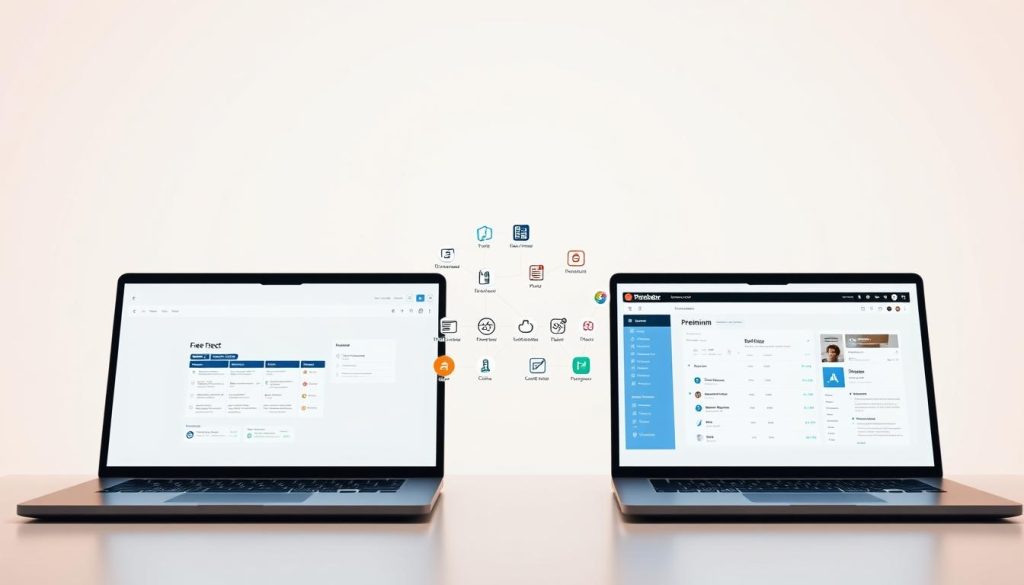
Limitations of Free Plans
Free project management tools can be an excellent starting point for small teams or simple projects. However, they often come with limitations that can impact growing teams. Common restrictions include:
- Limited user capacity
- Restricted storage space
- Limited views and project management methodologies
- Lack of advanced features such as automation and reporting
These limitations can hinder a team’s ability to manage complex projects efficiently. For instance, as a team grows, the need for more users and advanced features becomes apparent, making free plans less viable.
When to Upgrade to Paid Plans
Upgrading to paid project management plans is often necessary when teams hit the limitations of free plans. Key indicators that it’s time to upgrade include:
- Reaching user limits
- Needing advanced reporting and analytics
- Requiring enhanced security features
- Seeking more robust automation capabilities
Paid plans offer additional features that can significantly enhance a team’s productivity and project management capabilities. For example, advanced reporting can provide valuable insights into project progress, while enhanced security features can protect sensitive project data.
Best Value for Money Options
When considering paid project management tools, it’s essential to evaluate the value for money. Factors to consider include:
- Feature sets and their alignment with team needs
- Scalability of the tool
- Support options available
Some project management tools offer exceptional value for money by providing comprehensive features at competitive prices. For instance, tools like ClickUp and Asana offer robust feature sets that cater to a wide range of team needs, making them worthwhile investments.
By carefully evaluating the limitations of free plans, knowing when to upgrade to paid plans, and selecting tools that offer the best value for money, teams can make informed decisions about their project management software. This ensures that they have the right tools to manage their projects efficiently and effectively.
Integrations: Connecting Your Project Management Tool with Other Software
As we navigate the complexities of modern project management, the importance of seamless integrations cannot be overstated. In today’s digital landscape, a great project management tool should fit seamlessly into the rest of your stack, connecting with other popular software like email, Slack, calendars, and document storage.

Essential Integrations for Boosting Productivity
To significantly enhance productivity for project teams, certain integrations are crucial. These include connections with communication tools like Slack and Microsoft Teams, file storage services such as Google Drive and Dropbox, time tracking applications like Toggl and Harvest, and customer relationship management (CRM) systems.
- Communication tools: Slack, Microsoft Teams
- File storage services: Google Drive, Dropbox
- Time tracking applications: Toggl, Harvest
- Customer Relationship Management (CRM) systems
For instance, integrating your project management tool with Slack can streamline team communication, allowing team members to receive task updates and notifications directly within their Slack channels. Similarly, integrating with Google Drive or Dropbox enables easy access to project files without having to switch between applications.
Leveraging Zapier and API Connections
Zapier and similar automation platforms play a vital role in bridging gaps between tools that don’t offer direct integrations. By creating powerful workflows that span multiple applications, teams can automate repetitive tasks, enhance productivity, and reduce manual data transfer.
For example, using Trello’s Zapier integrations, you can connect Trello with your favourite apps like Gmail and Slack. Asana’s Zapier integrations allow you to create new Asana tasks from Google Calendar events or add new Typeform entries to Asana as tasks. ClickUp’s Zapier integrations enable you to create ClickUp tasks from Google Calendar events or add starred Gmail emails as tasks in ClickUp.
Creating a Seamless Workflow Ecosystem
Building a seamless workflow ecosystem around your project management tool requires thoughtful integration. By connecting your project management tool with other essential software, you can eliminate data silos, reduce manual data transfer, and enhance overall team productivity.
To achieve this, it’s essential to identify the key applications your team uses daily and ensure they are integrated with your project management tool. This might include integrating with email marketing tools, customer support software, or accounting applications.
By doing so, you can create a cohesive ecosystem where data flows smoothly between applications, enabling your team to focus on high-value tasks rather than manual data entry.
AI in Project Management: The Game-Changer for 2025
Artificial intelligence is set to redefine project management practices in 2025, moving beyond simple automation to provide intelligent assistance, predictive insights, and strategic recommendations. As we explore the impact of AI on project management, it becomes clear that this technology is not just an add-on but a fundamental shift in how projects are managed and executed.

How AI is Transforming Project Management
AI is enhancing project management processes in several key ways. Firstly, intelligent task assignment ensures that tasks are allocated to the most suitable team members based on their skills and workload. Secondly, automated status reporting provides real-time updates on project progress, reducing the administrative burden on project managers. Thirdly, predictive risk analysis identifies potential risks before they become critical issues, allowing for proactive mitigation strategies. Lastly, resource optimisation ensures that resources are utilised efficiently, reducing waste and improving productivity.
The integration of AI in project management is also improving project outcomes through more accurate forecasting, earlier risk identification, and optimised resource allocation. For instance, AI-powered tools can analyse historical data and current project metrics to predict potential delays or budget overruns, enabling project managers to take corrective action.
Tools with the Best AI Features
Several project management tools are now incorporating AI features to enhance their functionality. ClickUp Brain, for example, is an AI assistant that provides live, contextual answers from tasks, comments, docs, and connected apps, significantly reducing search fatigue. Other tools are also leveraging AI to offer advanced features such as predictive analytics, automated task assignment, and intelligent reporting.
When evaluating project management tools, it’s essential to consider the sophistication and practicality of their AI features. Tools that offer AI-driven insights and automation can significantly enhance project management efficiency and effectiveness.
Future AI Developments to Watch For
The future of AI in project management is promising, with several emerging developments worth watching. Natural Language Processing (NLP) will enable more intuitive interactions with project management tools, allowing users to ask questions and receive relevant information in a conversational manner. Predictive analytics will become more advanced, providing more accurate forecasts and recommendations. Additionally, machine learning applications will continue to improve, enabling tools to learn from project data and adapt to changing project requirements.
As AI continues to evolve, it’s crucial for project managers to stay informed about the latest developments and assess how these advancements can benefit their projects. By embracing AI, project managers can improve project outcomes, enhance efficiency, and drive innovation.
Mobile Project Management: Managing Projects On-the-Go
The rise of remote and hybrid teams has made mobile project management an essential tool for modern businesses. As teams become more distributed, the ability to manage projects effectively on mobile devices has become a top priority. In this section, we’ll explore the growing importance of mobile project management in 2025 and examine how it’s transforming the way teams work.
Best Mobile Apps for Project Management
Several project management tools have developed robust mobile apps to cater to the needs of on-the-go teams. Some of the top contenders include ClickUp, Asana, and Trello. These apps offer a range of features that enable team members to stay connected and productive, even when they’re not at their desks.
When evaluating mobile project management apps, it’s essential to consider factors such as user interface, feature parity with desktop versions, offline capabilities, and performance on various devices. A well-designed mobile app can significantly enhance team productivity and responsiveness.
| Tool | Mobile App Features | Offline Capability | Pricing |
|---|---|---|---|
| ClickUp | Task management, document access, push notifications | Yes | Free Forever; Unlimited: $7/month |
| Asana | Task management, workflow automation, reporting | Limited | Free; Premium: $10.99/month/user |
| Trello | Kanban boards, task management, card comments | Yes | Free; Business Class: $12.50/month/user |
Features to Look for in Mobile Project Management
Effective mobile project management relies on several key features. Push notifications are crucial for keeping team members informed about updates and changes. Quick task creation enables users to rapidly capture and assign tasks on the go. Document access allows team members to view and edit important project files from their mobile devices. Additionally, streamlined approval workflows facilitate faster decision-making and reduce bottlenecks.

When selecting a mobile project management tool, it’s essential to evaluate these features and determine which ones are most critical for your team’s specific needs.
Synchronisation Between Desktop and Mobile
Seamless synchronisation between desktop and mobile experiences is vital for maintaining productivity across different devices. The best project management tools ensure that data is consistently updated across all platforms, providing a unified view of project progress. This synchronisation enables team members to pick up where they left off, regardless of the device they’re using.
When evaluating project management tools, it’s crucial to assess their synchronisation capabilities. Look for tools that offer real-time updates, automatic data syncing, and minimal lag between devices. This ensures that your team can work efficiently, whether they’re at their desks or on the go.
Choosing the Right Project Management Tool for Your Needs
Selecting the ideal project management tool is a crucial decision that can significantly impact your team’s productivity and efficiency. As we’ve explored throughout this guide, there are numerous project management tools available, each with its unique strengths and features. In this concluding section, we’ll provide a comprehensive framework for selecting the right project management tool based on your team’s specific needs.
When evaluating project management tools, it’s essential to consider factors such as team size, project complexity, industry requirements, and specific workflow needs. For instance, smaller teams may prefer tools like Trello or Asana, which offer simplicity and ease of use, while larger teams may require more robust solutions like Wrike or Jira, which provide advanced features and scalability.
To make an informed decision, you’ll need to conduct an effective needs assessment. This involves identifying your team’s most critical pain points and determining how a project management tool can address them. We recommend asking key questions, such as: What are our primary project management challenges? What features are must-haves for our team? What is our budget for this tool? By answering these questions, you’ll be better equipped to choose a tool that meets your needs.
It’s also crucial to consider team preferences and working styles when selecting a project management tool. For example, some teams may prefer a visual Kanban-style approach, while others may prefer a more traditional task-listing approach. By choosing a tool that aligns with your team’s workflow, you’ll increase user adoption and ensure a smoother transition.
Running effective trials of project management tools is another vital step in the selection process. This involves testing key features, gathering feedback from team members, and evaluating the tool’s overall usability. We recommend trialling multiple tools to compare their strengths and weaknesses and determine which one best fits your team’s needs.
Once you’ve selected a project management tool, it’s essential to address potential implementation challenges. This may involve providing training and support to team members, configuring the tool to meet your specific needs, and integrating it with other software applications. By doing so, you’ll ensure a smooth transition and maximize the tool’s benefits.
Finally, it’s essential to periodically reassess your project management toolstack as your team’s needs evolve. This may involve re-evaluating your tool’s features, scalability, and pricing to ensure it continues to support your organisation’s growth and changing requirements. By regularly reviewing and adjusting your toolstack, you’ll be able to adapt to new challenges and opportunities, ensuring your team remains productive and efficient.
In conclusion, choosing the right project management tool requires careful consideration of your team’s specific needs, workflows, and preferences. By following the guidelines outlined in this section, you’ll be well-equipped to make an informed decision and select a tool that enhances your team’s productivity and efficiency. Whether you’re a small startup or a large enterprise, the right project management tool can make all the difference in achieving your project goals.
FAQ
What are the key features to look for in a task management tool?
When selecting a task management tool, we look for features such as time tracking, team collaboration, and customisable workflows. These features enable us to manage tasks efficiently and effectively.
How do I choose the best project management software for my team?
To choose the best software, we consider factors such as team size, industry, and specific needs. We also evaluate the software’s features, pricing, and integrations to ensure they align with our requirements.
What are the benefits of using a Kanban-style project management tool like Trello?
Trello’s Kanban-style board provides a visual representation of our work, enabling us to track progress and identify bottlenecks. This approach helps us to manage our work more efficiently and improve collaboration among team members.
Can I integrate my project management tool with other software applications?
Yes, many project management tools offer integrations with other software applications, such as calendar apps, time tracking software, and customer relationship management systems. These integrations enable us to create a seamless workflow ecosystem.
How do AI-powered project management tools like ClickUp and Asana enhance our productivity?
AI-powered tools provide features such as automated task assignment, predictive analytics, and smart scheduling. These features help us to streamline our workflows, reduce manual errors, and make data-driven decisions.
What are the limitations of free project management tools, and when should I upgrade to a paid plan?
Free plans often have limitations, such as restricted features, limited storage, or a limited number of users. We should upgrade to a paid plan when our needs exceed these limitations, or when we require more advanced features to manage our projects effectively.
How do I ensure synchronisation between desktop and mobile project management apps?
To ensure synchronisation, we should choose a project management tool that offers a robust mobile app with real-time updates. This enables us to access our project data and manage tasks on-the-go, while ensuring that our data remains up-to-date across all devices.










